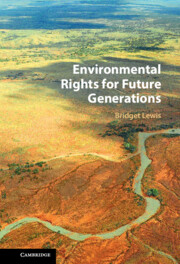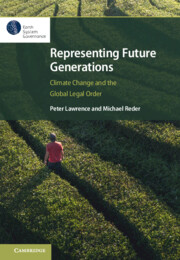Refine search
Actions for selected content:
60 results
The 2025 International Court of Justice Advisory Opinion on Obligations of States in respect of Climate Change
-
- Journal:
- International & Comparative Law Quarterly , First View
- Published online by Cambridge University Press:
- 15 December 2025, pp. 1-35
-
- Article
-
- You have access
- Open access
- HTML
- Export citation
Chapter 5 - Kantian Ethics and Sustainability
-
- Book:
- Kant and Environmental Philosophy
- Published online:
- 01 November 2025
- Print publication:
- 20 November 2025, pp 129-152
-
- Chapter
- Export citation
4 - The Problem
-
- Book:
- Environmental Rights for Future Generations
- Published online:
- 11 October 2025
- Print publication:
- 30 October 2025, pp 60-91
-
- Chapter
- Export citation
1 - Introduction
-
- Book:
- Environmental Rights for Future Generations
- Published online:
- 11 October 2025
- Print publication:
- 30 October 2025, pp 1-15
-
- Chapter
- Export citation
5 - New Theory and Practice
-
- Book:
- Environmental Rights for Future Generations
- Published online:
- 11 October 2025
- Print publication:
- 30 October 2025, pp 92-125
-
- Chapter
- Export citation
6 - Unconventional Natural Resource Extraction
-
- Book:
- Environmental Rights for Future Generations
- Published online:
- 11 October 2025
- Print publication:
- 30 October 2025, pp 126-154
-
- Chapter
- Export citation
7 - Climate Adaptation, Decarbonisation and Geoengineering
-
- Book:
- Environmental Rights for Future Generations
- Published online:
- 11 October 2025
- Print publication:
- 30 October 2025, pp 155-186
-
- Chapter
- Export citation
9 - Conclusion
-
- Book:
- Environmental Rights for Future Generations
- Published online:
- 11 October 2025
- Print publication:
- 30 October 2025, pp 214-218
-
- Chapter
- Export citation
2 - The Rationale
-
- Book:
- Environmental Rights for Future Generations
- Published online:
- 11 October 2025
- Print publication:
- 30 October 2025, pp 16-39
-
- Chapter
- Export citation
8 - Nuclear Energy
-
- Book:
- Environmental Rights for Future Generations
- Published online:
- 11 October 2025
- Print publication:
- 30 October 2025, pp 187-213
-
- Chapter
- Export citation

Environmental Rights for Future Generations
-
- Published online:
- 11 October 2025
- Print publication:
- 30 October 2025
5 - Lessons from Existing International Institutions to Represent Vulnerable Groups
- from Part II - International Law and Institutions
-
- Book:
- Representing Future Generations
- Published online:
- 19 September 2025
- Print publication:
- 09 October 2025, pp 116-142
-
- Chapter
- Export citation
2 - Proxy Representation and the Global Legal Order
- from Part I - Normative Framework
-
- Book:
- Representing Future Generations
- Published online:
- 19 September 2025
- Print publication:
- 09 October 2025, pp 23-47
-
- Chapter
- Export citation
6 - The ICJ Advisory Opinion on Climate Change and Proxy Representation of Future Generations
- from Part III - Case Studies
-
- Book:
- Representing Future Generations
- Published online:
- 19 September 2025
- Print publication:
- 09 October 2025, pp 145-177
-
- Chapter
- Export citation
9 - Conclusion
- from Part III - Case Studies
-
- Book:
- Representing Future Generations
- Published online:
- 19 September 2025
- Print publication:
- 09 October 2025, pp 220-232
-
- Chapter
- Export citation
3 - The Democratic Ideal and Its Normative Value for Future Generations
- from Part I - Normative Framework
-
- Book:
- Representing Future Generations
- Published online:
- 19 September 2025
- Print publication:
- 09 October 2025, pp 48-90
-
- Chapter
- Export citation
7 - A UN Committee on the Rights of the Child Case Study
- from Part III - Case Studies
-
-
- Book:
- Representing Future Generations
- Published online:
- 19 September 2025
- Print publication:
- 09 October 2025, pp 178-199
-
- Chapter
- Export citation

Representing Future Generations
- Climate Change and the Global Legal Order
-
- Published online:
- 19 September 2025
- Print publication:
- 09 October 2025
Overcoming Democratic Short-termism through Constitutional Law?—The Difficulty of Making the Constitutional Veto Work in Climate Protection Cases
-
- Journal:
- German Law Journal / Volume 26 / Issue 2 / March 2025
- Published online by Cambridge University Press:
- 01 September 2025, pp. 317-330
-
- Article
-
- You have access
- Open access
- HTML
- Export citation
9 - Duty of Care
- from Part II - Merits
-
-
- Book:
- The Cambridge Handbook on Climate Litigation
- Published online:
- 03 June 2025
- Print publication:
- 31 July 2025, pp 223-249
-
- Chapter
-
- You have access
- Open access
- HTML
- Export citation
